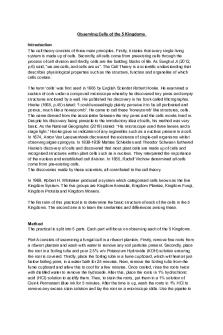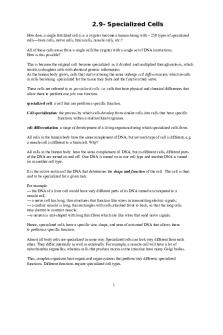Chapter 5- Cells PDF

| Title | Chapter 5- Cells |
|---|---|
| Course | Introduction To Biology |
| Institution | Idaho State University |
| Pages | 7 |
| File Size | 160.9 KB |
| File Type | |
| Total Downloads | 47 |
| Total Views | 157 |
Summary
Jennifer Abruzzes class
Biology 1101
...
Description
Transport across membranes Small Materials- 5 forms o Passive Transport (3) Simple Diffusion Small lipid like molecules can cross cell membranes by simple diffusion Small uncharged, small hydrophobic, neutral, lipid like -- all the same describers for the same thing. Yes, it can pass: cholesterol-based steroids No, it cannot pass: sugars and amino acids Osmosis Diffusion of solvent Water is small but polar. It may cross the membrane but the presence of aquaporin's can significantly increase the rate of transport Have proteins that give water a path to cross through membrane faster. Cell membranes restrict the movement of many solutes so water molecules move down their gradient instead. Movement of Water Phrase: water follows the solutes Hypertonic: higher concentration of materials. Solution around cell has greater concentration of dissolved materials/environment Dissolved material will NOT cross membrane Water flows to the area with a higher concentration Isotonic: same concentration of materials Solution has the same concentration inside and outside the cell NO GRADIENT Hypotonic: low concentration of materials Low concentration inside the cell Water flows into the cell Cells can burst. Facilitated Diffusion No energy is required to move the substance across membrane Net movement is determined by gradient Channels: gated Ions or small molecules through a protein pore.. Ligand: chemical signal Voltage: can sense change in charges Has to have a protein present Transporters/Carriers. No energy Binding, confrontational change and then release.. Determined by solute, number and direction. Has a pocket for chemicals to sit in 2 forms: Inside or outside facing pockets that can change sides Protein creates a path but still a form of diffusion Uniporter: one solute
o
o o
o o o o o o o o
Symporter: two chemicals moving in the same direction Antiporter: one chemical in and one out Active Transport Requires cells to use energy One substance will move up or against the gradient. Mediated by proteins(pump and/or transporter) Primary Transport Direct hydrolysis of ATP Protein will set in pocket until ATP interacts with the pocket.. Secondary transport Uses pre-existing gradient to drive transport Energy already used to build gradient. Wont change shape until a secondary chemical interacts. Large Materials- 2 Forms Mediated by Membrane Vesicles Endocytosis: material released to outside environment Endocytosis: Material brought in to cell Phagocytosis: cellular eating pinocytosis : cellular drinking Receptor mediated endocytosic: a receptor is when you need a chemical bound and the cells bring in the receptor and chemical. Can unbind from chemical later. Movement of Water Phrase: water follows the solutes Hypertonic: higher concentration of materials. Isotonic: same concentration of materials Hypotonic: low concentration of materials
5.1 MEMBRANE STRUCTURE
Structure determines function
Two primary components of membranes are phosoplipids and proteins
Carbohydrates are a third component Phosoplipid bilayer
framework of a membrane
2 layers of phospholipids
amphipathic molecules
membranes are a “mosaic” of lipid protein and carbohydrate molecules
fluid-mosaic model
proposed by S. Jonathan Singer and Garth Nicolson in 1972 membrane exhibits properties that resemble a fluid because lipids and proteins can move relative to each other within a membrane.
Leaflet
half of a phosoplipid bilayer
each leaflet faces a different region
Transmembrane Proteins: has one or more regions that are physically inserted into the hydrophobic interior of the phospholipid bilayer.
Regions are stretches of non-polar amino acids that span or travers the membrane from one leaflet to another Most transmembrane segments are folded into a -helix
Non polar amino acids interact favorable with hydrophobic lipid tails
ns
Cannot be released from membrane unless membrane is dissolved.
Peripheral Membrane proteins
Called extrinsic proteins Do not interact with hydrophobic interior but noncovalently bound to regions of integral membrane proteins that project out from the membrane
Or polar head grounds of phosoplipids
Typically attached to the membrane by ionic or hydrogen bonds
5.2 FLUIDITY OF MEMBRANES
fluidity: means individual molecules remain in close association yet have the ability to readily move within a membrane
semifluid: membranes are more accurately described
in a fluid substance, molecules can move in three dimensions
lipid composition affects membrane fluidity
length of phosoplipid tails
range from 14-24 carbon atoms with 16-18 being the most common
shorter tails are less likely to interact meaning its more fluid
double bonds in phospholipid tails
when double bonds are present the lipid is unsaturated which causes a kink in the tail and makes it hard for them to interact and making it more fluid.
Cholesterol
Present in animal cells
Phytosterls are similar for plants Tends to stabilize membranes but depends on temperature
At higher temps it makes it less fluid but at lower temps makes it more fluid
Membrane must be at ideal fluidity. If it’s to fluid, it can become leaky and to solid the membrane proteins will be inhibited.
1970 Larry Frye and Michael Edidin conducted an experiment that verified the later movement of transmembrane proteins.
5.3 SYNTHESIS OF MEMBRANE COMPONENTS IN EUKARYOTIC CELLS
cellular membranes composed of lipids, proteins and carbohydrates.
Most components are made at the ER
Cytosol and endomembrane system work together to synthesize most lipids.
Lipids are transported via vesicles to Golgi, lysosomes, vacuoles, or plasma membrane.
Lipid exchange proteins: extracts a lipid into another membrane, diffuse through the cell and insert the lipid into another membrane. Can be done between any 2 membranes, even between endomembrane system and semiautonomous systems.
Glycosylation: process of covalently attaching a carbohydrate to a lipid or protein.
When a carbohydrate is attached to a lipid it’s called a glycolipid
When a carbohydrate is attached to a protein it’s called a glycoprotein.
Glycolipids and glycoproteins are used in call surface recognition.
Two forms of glycosylation in eukaryotes
N-linked- also in archaea, involves attachment of a carbohydrate to the amino acid asparagine in a polypeptide. Carbohydrate is attached to a nitrogen atom on asparagine.
O-Linked- occurs in Golgi only involves addition of a string of sugars to the oxygen atom of serine or threonine side chains.
Important in animals for production of proteoglycans
Helps organize the extra cellular matrix around cells.
Also component of mucus
5.4 OVERVIEW OF MEMBRANE TRANSPORT
membrane transport: movement of ions and molecules across biological membranes selectively permeability: allowing passage of some ions and molecules but not others. Simple : when a substance moves from a region of high concentration to a region of low
concentration. 2. Facilitated diffusion: a transport protein provides a passageway for a substance
to move across membrane. 3. Active transport: moves a substance from an area of low concentration to an
area of high concentration.
Requires energy
Phosoplipids are barriers to ions and hydrophilic molecules
Called solutes when they are suspended in water
Called solution when they are dissolved in water. High Permeability
Moderate Low
Very Low
Gases
Water
ions
urea
Small uncharged molecules
Polar organic molecules
Charged polar molecules and macromolecules
Transmembrane gradient or concentration gradient: concentration of a solute is higher on one side of a membrane Electrochemical gradient: dual gradient with both electoral and chemical components.
Occurs when solutes have a positive or negative change
Isotonic: when solutes are the same concentration inside and outside the cell
Hypertonic: a higher concentration of solute on one side or the other of the cell.
Hypotonic: lower concentration of solute on one side of the cell.
osmosis: if solutes cannot be readily moved across membrane, water will move to the hypotonic side.
when a cell ruptures: osmotic lysis when a cell dehydrates: crenation cell walls prevent ruptures plasmolysis: when water exits cell and plasma membrane pulls away from cell wall. 5.5 TRANSPORT PROTEINS Transport proteins: transmembrane proteins that provide passageways for movement of ions and hydrophilic molecules across bilayer. Two categories: cannels and transporters Channel: transmembrane protein that forms an open passageway for the facilitated diffusion of ions or molecules. most channels are gated open to allow the diffusion of solutes and close to prohibit diffusion. Transporters (carriers): bind solutes in a hydrophilic pocket and undergoes a conformational change that switches pocket from one side to the other. Provide the principal pathway for the uptake of organic molecules such as sugars, amino acids and nucleotides. In animals they also allow cells to take in hormones and neurotransmitters. Also play a key role in export Waste products of cellular metabolism must be released before they reach toxic levels. Ion transport- regulates pH Named according to number of solutes they bind and direction they transport those solutes. Uniporters: bind a single ion and transport across membrane Symporters: bind two or more ions and transport molecules in the same direction. Antiporters: bind two or more ions and transport molecules in opposite direction. Active transport is energetically unfavorable and requires an input of energy.
Primary active transport: involves the function of a pump – a type of transporter that directly uses energy to transport a solute against a concentration gradient. Secondary active transport: involves the use of pre-existing gradient to drive the active transport of another solute. Active transport was discovered in the 1940s Electrogenic pump: generates an electrical gradient. Important functions of Ion Electrochemical Gradients – ATP is commonly the source of energy. Transport of ions and molecules Production of energy intermediates Osmotic regulation Neuronal signaling Muscle contraction Bacterial swimming 5.6 EXOCYTOSIS AND ENDOCYTOSIS Exocytosis: materials inside the cell is packaged into vesicles and excreted into the extracellular environment. Vesicles are usually from Golgi Endocytosis: the plasma membrane folds inwards to form a vesicle and bring substances into cell. Three types: Receptor-mediated endocytosis: a receptor in plasma membrane is specific for a given cargo. Cargo molecules bind to specific receptors and stimulate it causing the plasma membranes to form a vesicle. Pinocytosis: (Greek meaning cell-drinking) a vesicle is formed from plasma membrane as a well for cells to internalize the extracellular fluid. Important in cells that are active in nutrient absorption. Phagocytosis: (Greek meaning cell-eating) a vesicle is formed from an enormous membrane called phagosome and it engulfs a large particle. Only certain cells can carry out this process, such as macrophages (immune system of animals)...
Similar Free PDFs

Chapter 5- Cells
- 7 Pages

5 – NK Cells Worksheet
- 2 Pages

Chapter 2 Cells AND Tissues
- 8 Pages

Chapter 3 Cells and Tissues
- 2 Pages

Auxiliary Cells
- 1 Pages

Stem cells
- 1 Pages

ANHB1101 Cells
- 4 Pages

Stem Cells
- 1 Pages

Chapter 3: Cells - Lecture notes 3
- 13 Pages

Chapter 5 quiz #5
- 2 Pages
Popular Institutions
- Tinajero National High School - Annex
- Politeknik Caltex Riau
- Yokohama City University
- SGT University
- University of Al-Qadisiyah
- Divine Word College of Vigan
- Techniek College Rotterdam
- Universidade de Santiago
- Universiti Teknologi MARA Cawangan Johor Kampus Pasir Gudang
- Poltekkes Kemenkes Yogyakarta
- Baguio City National High School
- Colegio san marcos
- preparatoria uno
- Centro de Bachillerato Tecnológico Industrial y de Servicios No. 107
- Dalian Maritime University
- Quang Trung Secondary School
- Colegio Tecnológico en Informática
- Corporación Regional de Educación Superior
- Grupo CEDVA
- Dar Al Uloom University
- Centro de Estudios Preuniversitarios de la Universidad Nacional de Ingeniería
- 上智大学
- Aakash International School, Nuna Majara
- San Felipe Neri Catholic School
- Kang Chiao International School - New Taipei City
- Misamis Occidental National High School
- Institución Educativa Escuela Normal Juan Ladrilleros
- Kolehiyo ng Pantukan
- Batanes State College
- Instituto Continental
- Sekolah Menengah Kejuruan Kesehatan Kaltara (Tarakan)
- Colegio de La Inmaculada Concepcion - Cebu





